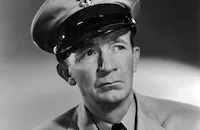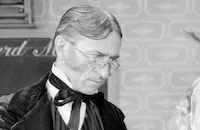A Ticket to Tomahawk
Brief Synopsis
Cast & Crew
Richard Sale
Dan Dailey
Anne Baxter
Rory Calhoun
Walter Brennan
Charles Kemper
Film Details
Technical Specs

Synopsis
In 1876, Johnny Jameson, a "drummer," or traveling salesman, is the only passenger on the inaugural run of the Tomahawk and Western Railroad's narrow gauge train through the Colorado Rockies. During the ride, the conductor tells Johnny that certain people, stagecoach operators for example, would like to see the railroad's franchise fail. Soon after, Dakota, Trancas and Gila, who work for Colonel Dawson, the area stageline operator, cause a giant boulder to fall directly in the path of the train. Engineer Terence Sweeny manages to stop the train in time, and he and the crew then disembark to move the rock. Johnny decides to walk to the town of Epitaph and hitches a ride with Trancas and Gila. At the sheriff's office, when Johnny tries to report the train's delay to deputy Chuckity Jones, he is knocked out Trancas. U.S. Marshal Kit Dodge, meanwhile, prepares to welcome the train with help from his tomboyish, knife-wielding granddaughter Kit. As they are leaving for the depot, however, the marshal and Kit are surprised by Trancas and Gila. The marshal shoots Trancas but is wounded by Gila. Kit suspects that Johnny may be one of the gang and, before Chuckity can intervene on his behalf, orders him to leave town. After Kit is deputized as a U.S. Marshal by her grandfather, she and an Indian named Pawnee are assigned to escort the train to Tomahawk. Colonel Dawson orders Dakota to join the posse that is escorting the train, while other gang members plot to blow up the engine during a night stop, which will be disrupted after Indian Black Wolf stirs up the local Arapahos. On the way to Tomahawk, local businessman Bishop informs Sweeny that there is no track laid for the next forty miles because the rails, which were shipped from England, have been lost at sea. Bishop explains that as the train must reach Tomahawk to fulfill the requirements of the franchise contract, he has arranged for the engine car to be hauled by teams of mules over the next forty miles. Another condition of the franchise contract is that the train must reach Tomahawk by a rapidly approaching deadline with at least one paying passenger. Although Johnny buys a ticket, he must sit alongside the train's boiler while the mules pull the locomotive, and Kit has to ensure his safe journey. Before the train departs, Chinese laundry man Long Time joins the group with laundry for Tomahawk. Madame Adelaide, her dancing girls and a musician also join up. As planned, Dawson's men Bat, Charley and Fargo show up at a night stop claiming to be telegraph men who are there to repair lines cut by the Arapahos and Kit gives them permission to bunk in the camp. Gradually, Kit softens her opinion of Johnny. When all are asleep, Bat and Charley leave while Fargo tosses sticks of dynamite under the engine. Johnny, who is sleeping alongside the train, smells the lit fuse and alerts the others. Kit then cuts the fuse with a shot and disables Fargo. Before Fargo can talk, however, Dakota kills him. Some time later, about five miles from where the track restarts, Bat and Charley place dynamite charges on a trestle bridge. They are then attacked by Indians and the dynamite is set off prematurely. Johnny knows the Arapaho chief, Crooked Knife, and after the Indians attack the train and accompanying wagons, Johnny volunteers to talk peace with him. Johnny has learned that Long Time is carrying a load of fireworks and develops a plan. He is welcomed by Crooked Knife, who agrees to allow the train safe passage. However, some of the braves distrust Johnny and ask him to produce a sign that he is "big medicine." Johnny sets off a rocket, signaling Kit and Dakota to set off the rest of the fireworks on a nearby hill, and the Indians are impressed. As the bridge is out, Kit intends to take the thirty-three-ton locomotive over a mountain by dismantling it and carrying it in sections. Dawson, meanwhile, thinks he has been double-crossed and shoots Black Wolf. He then rounds up his men for a final showdown. After Kit discovers that Dakota has sabotaged a water tower, Dakota slugs Johnny, orders the fireman to start the engine rolling and takes off at high speed down the tracks. Kit jumps into the cabin but is knocked out by Dakota. Johnny revives and while he and Dakota fight on top of the cabin, Kit recovers and throws a knife, causing Dakota to fall into a ravine. Dawson and his gang then try to ambush the train but cannot catch up with it. However, the boiler develops several leaks and the train slows to a halt. Dawson and his gang are driven off by the Indians, who ride to the rescue, and Pawnee throws a tomahawk at Dawson. As the train has stopped just short of its goal, Johnny talks the mayor of Tomahawk into extending the town limits, thereby fulfilling the requirements of the franchise. By now Kit has fallen in love with Johnny and jokingly threatens to cripple him to stop his wandering ways. Some time later, Johnny limps off to his job as train conductor, waving to his wife, Kit, and five daughters.

Director
Richard Sale
Cast

Dan Dailey

Anne Baxter

Rory Calhoun

Walter Brennan

Charles Kemper

Connie Gilchrist

Arthur Hunnicutt

Will Wright
Chief Yowlachie
Victor Sen Young
Mauritz Hugo
Raymond Greenleaf
Harry Carter
Harry Seymour
Robert Adler
Lee Macgregor
Raymond Bond
Charles Stevens
Chief Thundercloud

Marion Marshall

Joyce Mackenzie

Marilyn Monroe
Barbara Smith
Jack Elam

Paul Harvey
Charles Soldani
John War Eagle
Shooting Star
William Self
Guy Wilkerson
Edward Clark

Olin Howlin
George Melford
Robert Filmer
John Horan
John Merton
Paul Brinegar
Herbert Heywood
Joe Forte
William Gould
Tim Graham
Dick Ryan
Jim Toney
Jerry Sheldon
Clarence Straight
Crew
Robert Bassler
Jenifer Chatfield
Ken Darby
George W. Davis
William Eckhardt
W. D. Flick
Mack Gordon
Earle Hagen
Lillian Hokom
Renè Hubert
Harry Jackson
Alma Johnson
Harmon Jones
Charles Lemaire
Harry M. Leonard
Thomas Little
Mary Loos
Cyril Mockridge
Richard Mueller
Lionel Newman
Ben Nye
Pat O'hara
Frank Prehoda
John Read
Joe Rickards
Fred J. Rode
Irving Rosenberg
Richard Sale
Richard Sale
Stanley Scheuer
Fred Sersen
Herbert Spencer
Urban Thielman
Anthony Ugrin
Marie Walters
Harry Warren
Henry Weinberger
Lyle Wheeler
Kenny Williams
Darryl F. Zanuck

Film Details
Technical Specs

Quotes
Trivia
Notes
According to documents in the Twentieth Century-Fox Records of the Legal Department at the UCLA Arts-Special Collections Library, the studio bought Mary Loos and Richard Sale's original screenplay for $30,000 in February 1949. A studio press release in the AMPAS Library reveals that the husband and wife team were "rabid model railroaders" and had spent two years researching narrow-gauge railroads before writing the script. According to the files, the studio made a deal with the Rio Grande and Western Railroad to film on their track, which ran from Durango to Silverton in Colorado. In the film, Silverton doubled as both of the fictional towns of Epitaph and Tomahawk. The Durango to Silverton line, a civil engineering feat, was built to haul silver and gold ore from the San Juan Mountains.
The railroad made its inaugural run in early July 1882 and operated for many years. Another film, Paramount's The Denver & Rio Grande, shot a spectacular head-on collision of two engines on the line in July 1951. In June 1967 the National Park Service officially designated the railroad a Registered National Historical Landmark, and the following year the American Society of Civil Engineers designated it as a National Historic Civil Engineering Landmark. In the early 1980s, after four years of negotiations, Charles E. Bradshaw, Jr., a Florida citrus grower, bought the Silverton Line for $2.2 million in cash. The railroad, restored with total authenticity, reopened on May 23, 1981 as a tourist attraction. According to a Hollywood Reporter news item, the A Ticket to Tomahawk company was scheduled to return to the studio on September 23, 1949 after six weeks of location filming in Colorado. Shooting of interiors at the studio ran into mid-October 1949.
Several reviews of the film incorrectly spell the names of the characters played by Walter Brennan, Lee MacGregor, Charlie Stevens and Edward Clark. Shortly after the film opened, Motion Picture Herald reported that some exhibitors were dissatisfied with its title. Executives of the Orpheum Theatre in Tulsa advertised the film as The Sheriff's Daughter (albeit the principal female character is a marshal's granddaughter). Variety reported that Fox would test the new title in Memphis, but by that time, the film had already played in most key cities. A radio version of the film, featuring Dan Dailey and Anne Baxter, was broadcast on the Lux Radio Theatre on June 4, 1951.

Miscellaneous Notes
Released in United States Spring May 1950
Released in United States Spring May 1950











